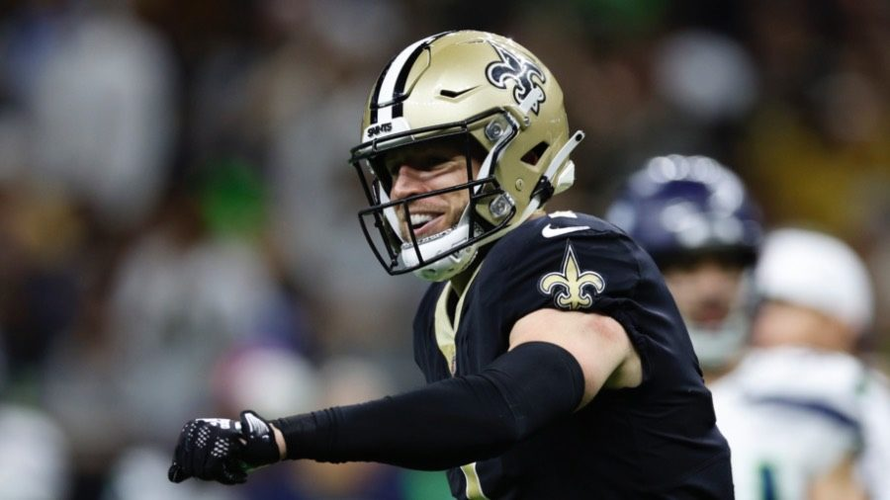
Credit: Chris Graythen - Getty Images
By Dan Levy - Staff Writer - Saintsreport.com
The New Orleans Saints are a good team. They're just running out of time to show it.
Going into Sunday’s game vs. the Seattle Seahawks, the Saints led the league in two major categories: turnovers and penalties.
This is a jarring stat. One that, in a macro sense, made the Saints 1-3 record seem not only logical, but fortunate. Those numbers—along with the myriad of embarrassing rankings that the Saints have compiled through the first month of the season, particularly on offense—usually land a team with a goose egg in the win column, no matter how talented they may be.
And still you couldn’t be blamed as a fan if the facts confounded you. After all, this is a team that by all accounts added to its talent pool in the offseason, and also managed to retain the majority of its coaching staff. But more than anything, there has just been this vague feeling that the turnovers and penalties weren’t just the cause of the Saints struggles, but also the result.
And it’s true. As a coach, I am keenly aware of the cascade effect and negative feedback loop between losses and mistakes. As a team struggles to move the ball, to convert third downs, and to capitalize red zone opportunities—and thus to win games—penalties and turnovers tend to pile on. And not from rookies and role players. Rather it is the team’s playmakers that are putting the ball on the ground. Alvin Kamara. Mark Ingram. Taysom Hill. Deonte Harty.
This is a common phenomenon. Players feel more pressure to make plays when they aren’t there because of what I like to call the “opportunity drought.” When you’re struggling to keep drives going, to stay on schedule and in front of the chains, it is your playmakers who begin to press. They don’t fumble because they’re being egregiously loose with the ball. They fumble because they are so focused on manufacturing yards that they lose some situational awareness. The defender flying in from their six. The hand punching in. They lose focus on the snap count, on their hand placement. Maybe a lineman tries to hold for an extra second to get their RB the edge. Maybe a DB gets a little more handsy with a receiver releasing off the line.
In short, not only do penalties and turnovers create losses and inefficiency, but inefficiency and losses also create penalties and turnovers.
The good news is all it takes is one game to break the cycle. That infusion of confidence, that, “Hey, we can still make big plays, we can still move the ball” can turn a season around. Players will stop overpressing, will play with more patience. And if the Saints can stack a few more wins on top of the one they just notched, they will be right back in the playoff hunt.
Anatomy of a Play: Taysom Hill
Taysom Hill is the best football player in the NFL.
Yes, you read that right. He is the best football player in the NFL. There may be better quarterbacks, better tight ends, better runners and special teams aces—but there is no single player who is as good at all of those things as Taysom Hill. The Saints’ staff can go on all they want about how Taysom’s touches and his role vs. the Seahawks were game-specific—gameplan, flow, etc.—but there is no reason he shouldn’t be used like this every single game. And if he were my player, he would finish the season with 800-1000+ yards rushing.
But the game broadcasts fail to tell the full story. So let’s take a look at why Taysom Hill is so impossible to stop. But before we get to play design, you must understand the nature of the 11-man run game and how it is different from the read option—and why Taysom Hill is the most dangerous player in the league when it comes to this particular brand of football. And yes, I’m including the likes of Lamar Jackson and Kyler Murray, because those guys don’t line up in heavy sets, run downhill gap plays, and bowl over linebackers.
You probably heard the announcers say multiple times, “Well, you know the run is coming, but you can’t stop it.” This is because when you go 11-man run game with a 240-pound QB who runs a 4.4 and is a legitimate passer in this league (remember that Taysom has a winning record and a near-70% completion percentage as starting QB), you now only have one free hitter and are forced to play 0 coverage. By using gap runs, the offense is forcing that free hitter—who would typically be a free safety, but is now adding into the second-level run fits—to scrape across the formation and make fits in traffic. Throw in a little creativity with formation and play design, and your offense can become absolutely unstoppable on 3rd down and in the red zone.
So let’s break it down. As usual, I recommend watching the clips at half-speed.
https://youtube.com/clip/Ugkx9btHyOEmg2pw14-kDhJ9M6xUz8faELTB
Here you have 21 personnel (2 backs, 1 TE) QB Power with a Swing RPO. The run design is simple. You have down-gap blocking playside (every offensive lineman responsible for their backside gap, or “down blocks”), the fullback kicking out the edge, and the backside guard pulling around to block the playside linebacker.
But what makes the play work—and even more difficult to stop—is that Hill also has a pass option. The pre-snap motion to put Kamara on the swing places the backside LB in conflict: either he fits on the run (he has to scrape playside and fit off the pulling guard) or he expands to play Kamara on the swing. If he does not expand, there is a numbers advantage on the swing because Kamara has 1 WR to block 1 defender. If he does expand, then Hill is automatically one-on-one with the safety, who must now make a perfect run fit on a 240-pound, 4.4-running centaur hitting the hole with a head full of steam.
Here you can see Hill punching his backfoot and peeking to the backside LB, who has already opened his hips to expand and play Kamara on the screen. Hill immediately has his read: keep the ball and run Power.
Number 6, the safety, is the free hitter. Because the playside linebacker does not fit on the pulling guard’s inside shoulder and spill the play outside, the safety's fit is out of position. Hill hits the hole with force, and poor number 6 has no chance of tackling him short of the end zone. And I say “poor number 6” because this will not be the last time he is be the victim of great play design putting in a terrible one-on-one situation with the best football player in the NFL.
https://youtube.com/clip/UgkxqmGJ3HqqeNjRnlahIYJ1AH3_kBXZZAHi
Eleven personnel, Lead QB Draw with a Swing RPO. Different run scheme but essentially the same RPO design. Here you have Hill sending Olave in “yo-yo” motion (in and out of the backfield) on the same swing that we saw with Kamara on the previous TD. Again, Hill is reading the backside LB and taking the numbers advantage: 3-on-2 vs. the swing, or +1 in the run game.
The lighter personnel, spread formation, pre-snap motion, and “high hat” pass-set look from the offensive line actually gets Hill a two-for-one on this play, with both backside linebackers expanding for the pass. This does not happen if you are running a true wildcat, with a RB or a WR taking the snap, because there is no legitimate passing threat. Hill gets an easy read, and the play design even affords Dwayne Washington an give-me block because the force player isn’t stepping up to fit against the run, he is coming to balance to cover Washington on a route!
Hill’s speed does the rest, and the result is another touchdown that is, quite literally, impossible to stop.
https://youtube.com/clip/Ugkxg9z7RChNC1dcNQ3tixlIUaLRJLtchF_F
This play actually shows Hill abandoning his read, but I’m including it because it demonstrates 1) his situational awareness and 2) his confidence in his own ability.
It’s another spread look, this time with an empty backfield and what I call a “Punch Power” run concept, where the guard is pulling to kick and the TE is releasing straight to the playside LB. The Backside LB is the conflict player, and no one is assigned to block him. Taysom’s read is if that backside LB expands to play Ingram on the bubble or steps up to fit against the run.
The LB actually makes a savvy move here. He is apexed out over Ingram, but adds into the run count right before the snap. He knows what play is coming. Taysom sees it, and even though he has a 3-on-2 advantage with Ingram on the bubble, one of those blockers outside is Andy Dalton. Taysom trusts his own legs here, and even though the read, strictly speaking, is telling him to throw the bubble, he knows he is going to run through that LB’s tackle and get the first down—which is exactly what he does.
https://youtube.com/clip/UgkxX2FzRsSe8ZnkwXnZMeUhlm7B-s0Lvkl8
Last but not least, we have the play of the game. There is no window dressing here. No RPO. The Saints are out of their spread looks and have gone into a heavy run set, with two extra offensive linemen (that’s right, seven offensive linemen) and three tight ends. This is going to be a gap run, all the way, and everyone on the field, in the stadium, and in the broadcast booth knows it.
The play is QB Counter, with the backside guard pulling to kick out the edge and the FB/TE (it's a tight end offset next to Taysom) leading up on the LB. Poor number 6, the Seahawks safety, will once again be the free hitter, responsible for fitting on the run and making a one-on-one tackle against Taysom Hill.
The prospect of stopping Hill from moving the chains here is a near-impossibility, but number 6 actually does make a solid read and fit. What blows the play wide open is the kickout block from Cesar Ruiz, who drives the force player out to the numbers. The sheer size of the hole allows Hill to maintain his velocity and change the angle of the safety fitting for the tackle.
As an aside, this is why I always teach my DBs that if they are faced with a 300-pound offensive lineman coming to kick them out, to go low and cut them (creating a pile and keeping the hole somewhat compressed). But hey, easier said than done. The end result here is that instead of Hill maybe taking the safety for a ride—or being slowed down enough for other defenders to get off blocks and rally—he runs through a desperate arm tackle and is off to the races.
Taysom Hill was the decisive difference in the Saints offense this week. And while there is a legitimate point to be made that the Seahawks defense is going through some trials of its own, strong 11-man run/RPO play design is difficult for any defense to handle—especially when the offense they’re facing has a QB who might as well have been built in a lab for exactly this purpose. If I am Pete Carmichael, a big part of my weekly gameplan from now until the end of the season is figuring out a way to get Taysom Hill 10-to-15 QB snaps per game—especially on third down and in the red zone.
Last edited:

